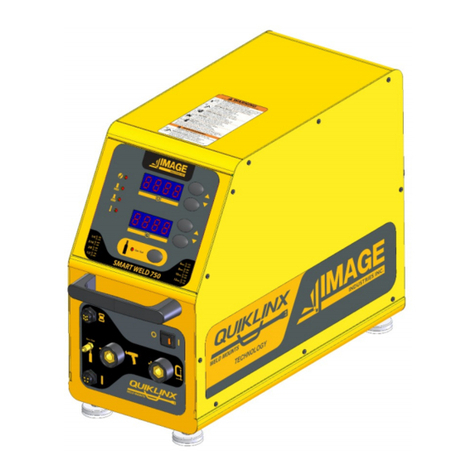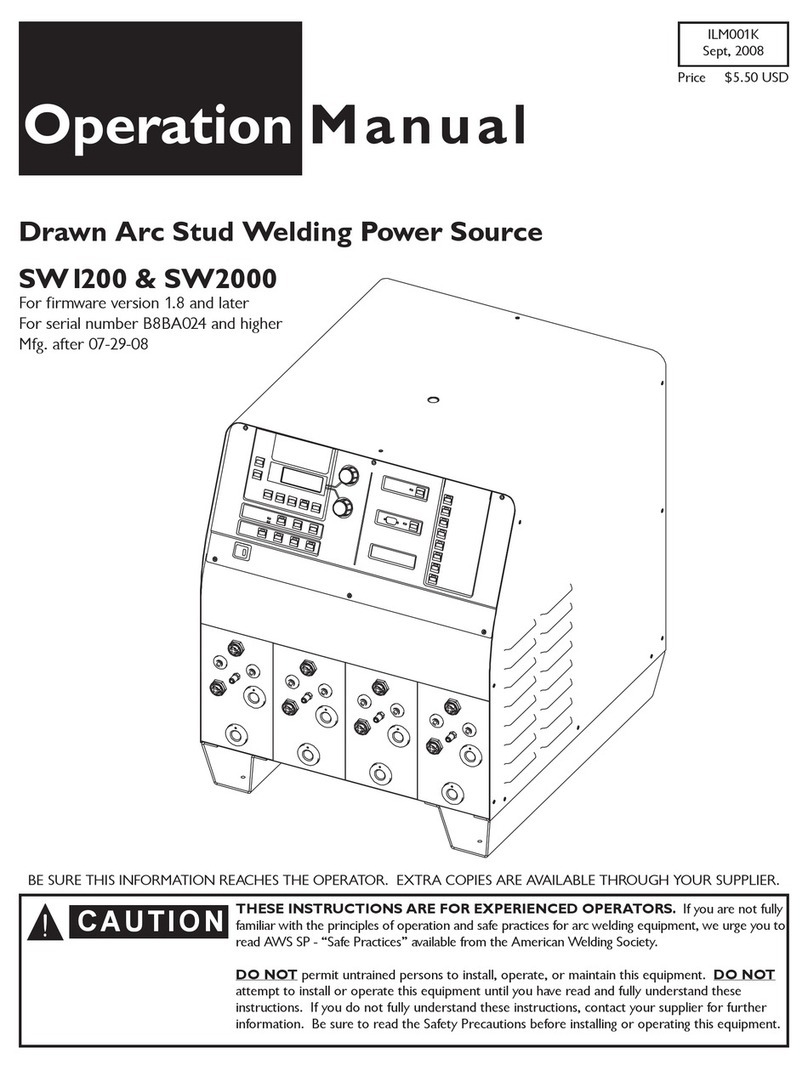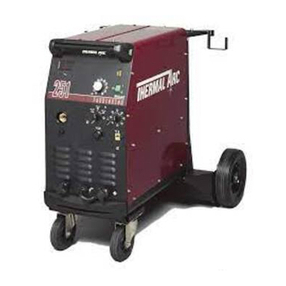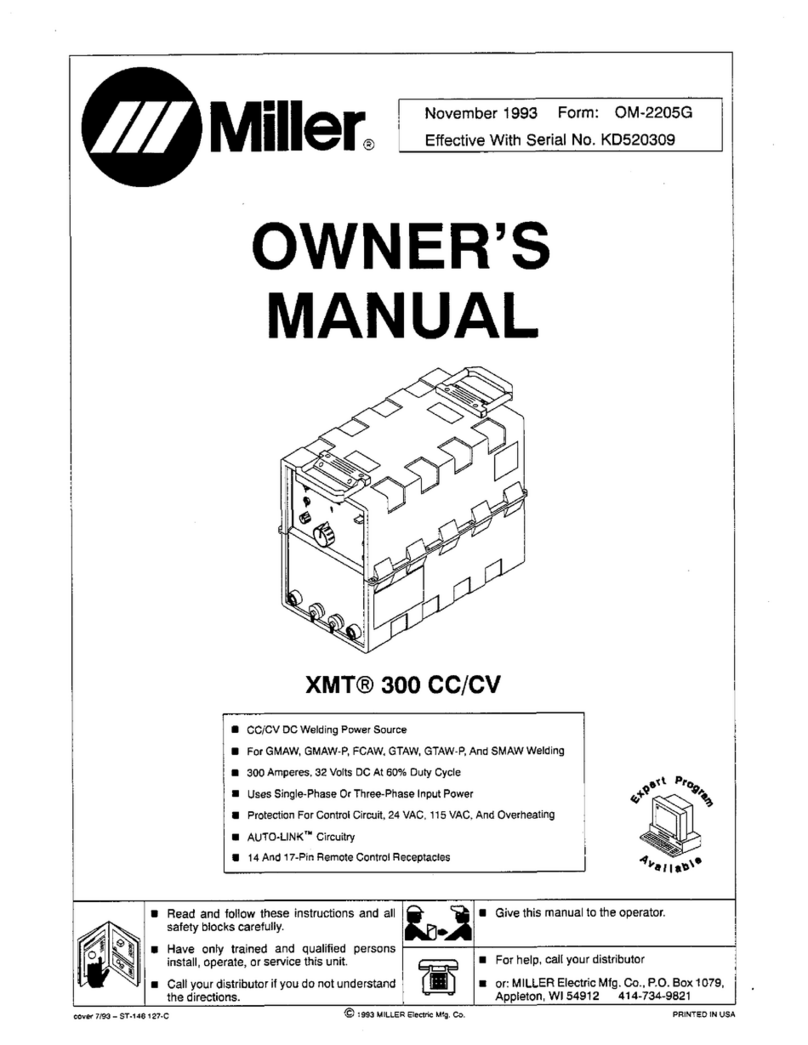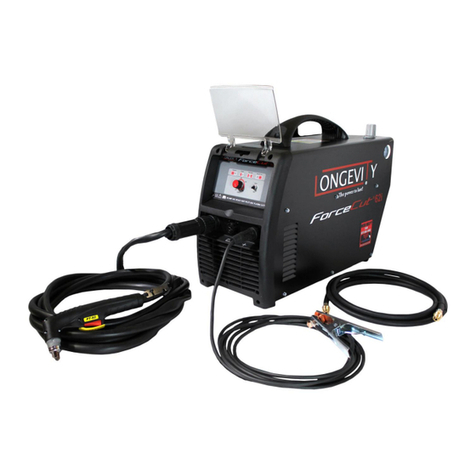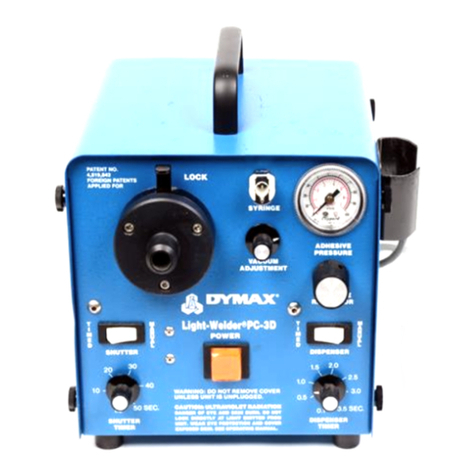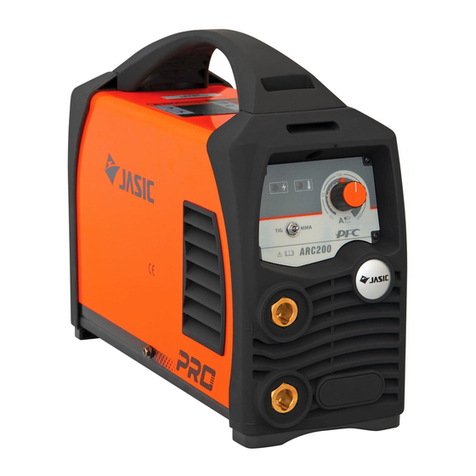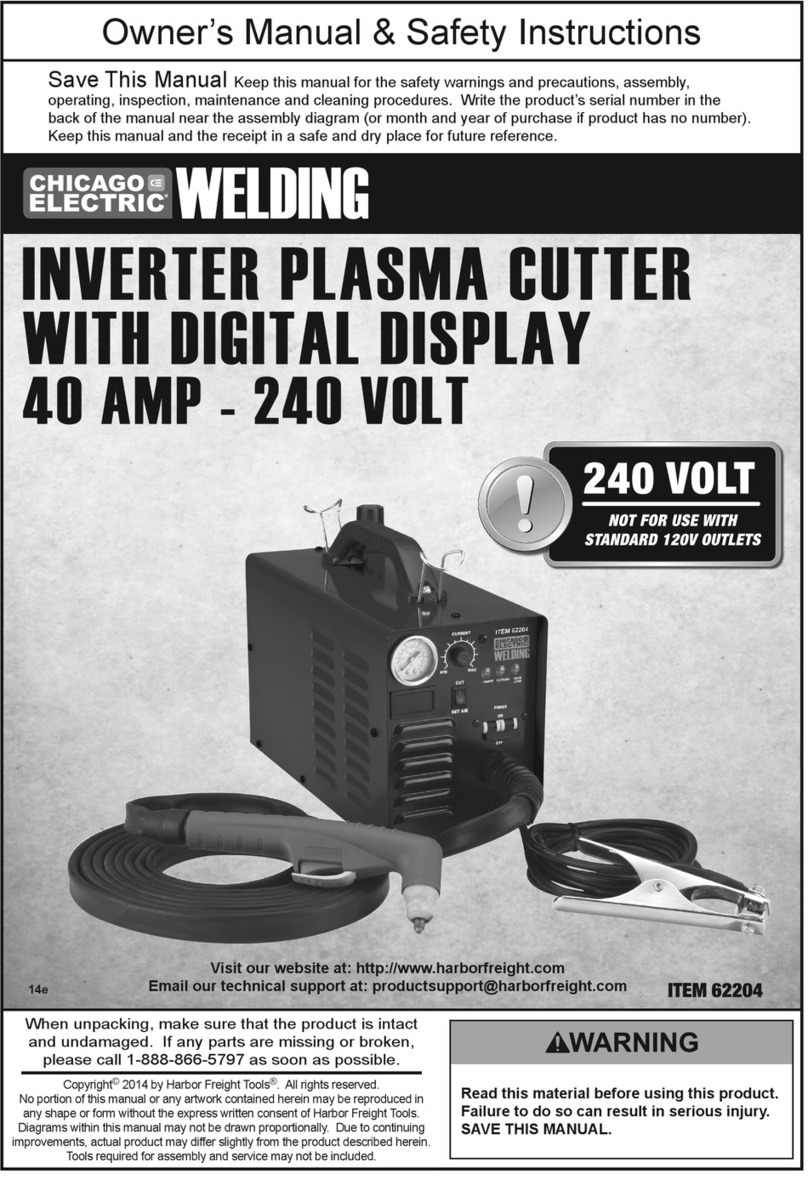Image Industries CD 110 User manual

ILM004D
June, 2007
Capacitor Discharge Stud Welding Power Source CD110
Price $5.50 USD
Operation Manual
These INsTRUCTIONs aRe fOR expeRIeNCed OpeRaTORs. If you are not fully
familiar with the principles of operation and safe practices for arc welding equipment, we urge
you to read AWS SP - “Safe Practices” available from the American Welding Society.
DO NOT permit untrained persons to install, operate, or maintain this equipment. DO NOT
attempt to install or operate this equipment until you have read and fully understand these
instructions. If you do not fully understand these instructions, contact your supplier for further
information. Be sure to read the Safety Precautions before installing or operating this equipment.
BE SURE THIS INFORMATION REACHES THE OPERATOR. EXTRA COPIES ARE AVAILABLE THROUGH YOUR SUPPLIER.
CAUTION

2
Table of Contents
SECTION 1: Safety Precautions 3
SECTION 2: Set Up 8
SECTION 3: Normal Operation 11
SECTION 4: Trouble Shooting 15
SECTION 5: System Maintenance 18
SECTION 6: Schematic Diagram 19
SECTION 7: Parts List 20
W A R R A N T Y
Image warrants that the goods sold will be free from defects in workmanship and material. This warranty is
expressly in lieu of other warranties, expressed or implied or for fitness for a particular purpose. The liability shall
arise only upon return of the defective goods at Buyer’s expense after notice to Image. The warranty shall be
limited to replacement with like goods or, at Image’s option, to refunding the purchase price. Image will not accept
receipt of equipment returned unless buyer has previously afforded Image’s personnel a reasonable opportunity
to inspect and repair said equipment. Image will warrant components for 1 year and labor for 180 days from date
of shipment. Image shall not be liable for any consequential damages including improper set up by customer.

3
Safety Precautions
Section 1
USERS RESPONSIBILITY
This equipment will perform in conformity with the description contained in this manual and accompanying labels and/or
inserts when installed, maintained and repaired in accordance with the instructions provided. This equipment must be checked
periodically. Defective equipment should not be used. Parts that are broken, missing, worn, distorted or contaminated
should be replaced immediately. Should such repair or replacement become necessary, the manufacturer recommends
that a telephone or written request for service advice be made to the Authorized Distributor from whom purchased.
This equipment or any of it’s parts should not be altered without the prior written approval of the manufacturer. The user
of this equipment shall have the sole responsibility for any malfunction which results from improper use, faulty maintenance,
damage, improper repair or alteration by anyone other than the manufacturer or a service facility designated by the
manufacturer.
WARNING: These Safety Precautions are for your protection.
They summarize precautionary information from the references
listed in the Additional Safety Information section. Before
performing any installation or operating procedures, be sure to
read and follow the safety precautions listed below as well as all
other manuals, material safety data sheets, labels, etc. Failure to
observe Safety Precautions can result in injury or death.
This symbol appearing throughout this manual means
ATTENTION! BE ALERT!
Your safety is involved.
The following definitions apply to DANGER, WARNING, CAUTION
found throughout this manual.
Used to call attention to immediate haz-
ards which, if not avoided, will result in
immediate, serious personal injury or loss
of life.
Used to call attention to potential hazards
which could result in personal injury or lost
of life.
Used to call attention to hazards which
could result in minor personal injury.
CAUTION
WARNING
DANGER

4
Safety Precautions
Section 1
ARC RAYS CAN BURN EYES AND SKIN -
The arc, like the sun, emits ultraviolet and infrared (visible and
in-visible) and other radiation and can injure skin and eyes.
Sparks and hot metal can fly off the weld. Training in the proper
use of the processes and equipment is essential to prevent ac-
cidents. Therefore:
1) Always wear safety glasses with side shields in any work area, even if wearing a
welding helmet, face shields and goggles are also required.
2) Always use a face shield fitted with the correct shade of filter to protect your
face and eyes when welding or watching (See ANSI Z49.1 and Z87.1 listed
in Safety Standards). Cover sparks and rays of the arc when operating or
observing operations.
3) Use protective non-flammable screens or barriers to protect others from
flash and glare. Warn bystanders not to watch the arc and not to expose
themselves to the rays of the electric-arc or hot metal.
3) Wear flameproof gauntlet type gloves, heavy long-sleeve shirt, cuffless trou-
sers, high topped shoes, and a welding helmet or cap for hair protection, to
protect against arc rays and hot sparks or hot metal. A flameproof apron may
also be desirable as protection against radiated heat and sparks.
4) Hot sparks or metal can lodge in rolled up sleeves, trousers cuffs or pockets.
Sleeves and collars should be kept buttoned, and open pockets eliminated
from the front of clothing.
6) Use goggles over safety glasses when chipping slag or grinding. Chipped slag
may be hot and can fly far. Bystanders should also wear goggles over safety
glasses.
ELECTRICAL SHOCK -
Contact with live electrical parts and ground can cause severe
injury or death. The electrode (the weld stud and chuck) and
work circuit (ground) are electrically live whenever the output
is on. The input power circuit and the machine internal circuits
are also live whenever power is on. Improperly installed or
improperly grounded equipment is a hazard.
1) Disconnect input power before installing or servicing this equipment. Lock-
out/tagout input power according to OSHA 29 CFR 1910.147 (see Safety
Standards).
2) Do not touch live electrical parts. Do not touch the electrode (stud) if you
are in contact with the work, ground, or another electrode from a different
machine.
3) Be sure the power source frame (chassis) is connected to the ground system
of the input power.
4) When making input connections, attach proper grounding conductors first and
then double-check connections.
5) Always verify the supply ground - check and be sure that input power cord
ground wire is properly connected to ground terminal in disconnect box or
that cord plug is connected to a properly grounded receptacle outlet.
6) Refer to ANSI/ASC Standard Z49.1 (listed on page 6) for specific grounding
recommendations. Do not mistake the work lead for a ground cable.
7) Clamp work cable with good metal-to-metal contact (spring and/or magnetic
clamps are not recommended) to work piece as near the weld as practical.
8) DO NOT use welding current in damp areas, if movement is confined, or if
there is danger of falling.
9) Properly install and ground this equipment according to this Owner’s Manual
and national, state and local codes.
10) Connect the work cable to the work piece. A poor or missing connection can
expose you or others to a fatal shock.
11) Keep everything dry, including clothing, work area, cables, torch/electrode
holder and power source.
12) Wear dry, hole-free insulated gloves & body protection before turning on
power.
13) Insulate yourself from work and ground using dry insulating mats or covers big
enough to prevent any physical contact with the work or ground.
14) Don’t stand directly on metal or the earth while working in tight quarters or a
damp area; stand on dry boards or an insulating platform and wear rubber-
soled shoes.
15) Turn off all equipment when not in use.
16) Use well-maintained equipment. Frequently inspect input power cord and out-
put weld cables for damage or bare wiring. Replace worn or damaged cables
immediately; bare wiring can kill. Repair or replace damaged parts at once.
Maintain this unit according to the manual.
17) Do not use worn, damage, undersized or poorly spliced cables.
18) Do not drape cables over your body.
19) If earth grounding of the work piece is required, use a separate cable.
20) Wear a safety harness if working above floor level.
21) Keep all panels and covers securely in place.
22) Insulate work clamp when not connected to work piece to prevent contact
with any metal object.
23) Don’t connect multiple electrodes or work cables to a single weld output
terminal.
SIGNIFICANT DC VOLTAGE exists after removal of the input power on
inverters. Turn off inverter, disconnect input power, and discharge input
capacitors according to instructions in Maintenance Section before touching
any parts.
ELECTRIC AND MAGNETIC FIELDS -
Electric and Magnetic Fields may be dangerous. Electric current
flowing through any conductor causes localized Electric and
Magnetic Fields (EMF). Welding and cutting current creates EMF
around welding cables and welding machines.
Therefore:
1) Welders having pacemakers should consult their physician before welding.
EMF may interfere with some pacemakers.
2) Exposure to EMF may have other health effects which are unknown.
3) Welders should use the following procedures to minimize exposure to EMF:
A) Route the electrode and work cables together. Secure them with tape
when possible.
B) Never coil the torch or work cable around your body.
C) Do not place your body between the torch and work cables. Route
cables on the same side of your body.
D) Connect the work cable to the work piece as close as possible to the
area being welded.
E) Keep welding power source and cables as far away from your body as
possible.
FLYING METAL CAN INJURE EYES -
1) Welding, chipping, wire brushing and grinding can cause
sparks and flying metal. As welds cool, they can throw
off slag.
2) Wear approved safety glasses with side shields even under
your welding helmet.
BUILD UP OF GAS CAN INJURE OR KILL -
1) Shut off shielding gas supply when not in use.
2) Always ventilate confined spaces or use approved air-
supplied respirator.

5
Safety Precautions
Section 1
CYLINDER HANDLING -
Shielding gas cylinders contain gas under high pressure. If dam-
aged or mishandled a cylinder can explode and violently release
gas. Sudden rupture of cylinder, valve, or relief device can injure
or kill. Since gas cylinders are normally part of the welding
process, be sure to treat them carefully. Therefore:
1) Protect compressed gas cylinders from excessive heat, mechanical shocks,
slag, open flames, sparks and arcs.
2) Keep cylinders away from any welding or other electrical circuits
3) Never drape a welding tool over a gas cylinder
4) Never allow a welding electrode (weld stud) to touch any cylinder
1) Use the proper gas for the process and use the proper pressure reducing
regulator, hoses and fittings designed to operate from the specific
compressed gas cylinder. Do not use adaptors. Maintain hoses and fittings
and other associated parts in good condition.
2) Always secure cylinders in an upright position by chain or strap to suitable
hand trucks, undercarriages, benches, walls, post, or racks. Never secure
cylinders to work tables or fixtures where they may become part of an
electrical circuit.
3) When not in use, keep cylinder valves closed. Have valve protection cap
in place if regulator is not connected. Secure and move cylinders by using
suitable hand trucks. Avoid rough handling of cylinders.
4) Locate cylinders away from heat, sparks, and flames. Never strike an arc or
weld on a cylinder; it will explode.
6) Turn face away from valve outlet when opening cylinder valve.
5) For additional information, refer to CGA Standard P-1, “Precautions for
Safe Handling of Compressed Gases in Cylinders”, which is available from
Compressed Gas Association, 1235 Jefferson Davis Highway, Arlington, VA
22202
WELDING CAN CAUSE FIRES AND EXPLOSIONS -
Welding on closed containers, such as tanks, drums or pipes, can
cause them to blow up. Sparks can fly off from the welding arc.
The flying sparks, hot work piece, and hot equipment can cause
fires and burns. Accidental contact of electrode to metal objects
can cause sparks, explosion, overheating or fire. Check and be
sure the area is safe before doing any welding. Therefore:
1) Protect yourself and others from flying sparks and hot metal.
2) Do not weld where flying sparks can strike flammable material.
3) Remove all combustible materials a minimum of 35ft away from the welding
arc or cover the materials with a protective nonflammable covering. Com-
bustible materials include wood, cloth, sawdust, liquid and gas fuels, solvents,
paints and coatings, paper, etc.
4) Hot sparks or hot metal can fall through cracks or crevices in floors or wall
openings and cause a hidden smoldering fire or fires on the floor below. Make
certain that such openings are protected from hot sparks and metal.
5) Do not weld, cut, or perform other hot work until the work piece has been
completely cleaned so that there are no substances on the work piece which
might produce flammable or toxic vapors.
6) Be aware that welding on a ceiling, floor, bulkhead or partition can cause fire
on the hidden side.
7) Do not weld on closed containers such as tanks, drums or pipes unless they
are properly prepared according to AWS F4.1.
8) Connect work cable to the work as close to the welding area as practical to
prevent welding current from traveling long, possibly unknown paths and caus-
ing electric shock and fire hazards.
9) Do not use welder to thaw frozen pipes.
10) Remove electrode (weld stud) from the stud weld tool when not in use.
11) Remove any combustibles, such as a butane lighter or matches from your
person before doing any welding.
12) Have appropriate fire extinguishing equipment handy for instant use, such as
a garden hose, water pail, sand bucket or portable fire extinguisher. Be sure
you are trained for proper use.
13) Do not use equipment beyond its ratings. For example, overloaded welding
cable can overheat and create a fire hazard.
14) After completing operations, inspect the work area to make certain there are
no hot sparks or hot metal which could cause a later fire. Use fire watchers
when necessary.
15) For additional information, refer to NFPA Standard 51B, “Fire Prevention
in Use of Cutting and Welding Processes,” available from the National Fire
Protection Association, Batterymarch Park, Quincy, MA 02269
FUMES AND GASES -
Welding produces fumes and gases. Breathing these fumes and
gases can be hazardous to your health, particularly in confined
spaces. Do not breathe fumes and gases. Shielding gases can
cause asphyxiation. Therefore:
1) Keep your head out of the fumes. Do not breathe the fumes.
2) If inside, ventilate the area and/or use exhaust at the arc to remove welding
fumes and gases.
3) If ventilation is poor, use an approved air-supplied respirator.
4) Read the Material Safety Data Sheets (MSDS) and the manufacturer’s
instructions for metals, consumables, coatings, cleaners and degreasers.
5) Work in a confined space only if it is well ventilated, or while wearing an
air-supplied respirator. Always have a trained watch-person nearby. Welding
fumes and gases can displace air and lower the oxygen level causing injury or
death. Be sure the breathing air is safe.
6) Don’t weld in locations near degreasing, cleaning or spraying operations. The
heat & rays of an arc can react with vapors to form highly toxic & irritating
gases.
7) Don’t weld on coated metals, such as galvanized, lead or cadmium plated
steel, unless the coating is removed from the weld area, the area is well
ventilated, and if necessary, while wearing an air-supplied respirator. The
coatings and any metals containing these elements can give off toxic fumes if
welded.
8) Do not weld, cut, or gouge on materials such as galvanized steel, stainless
steel, copper, zinc, lead, beryllium or cadmium unless positive mechanical
ventilation is provided. Do not breathe fumes from these materials.
9) If your develop momentary eye, nose, or throat irritation while operating, this
is an indication that ventilation is not adequate. Stop work and take necessary
steps to improve ventilation in the work areas. Do not continue to operate if
physical discomfort persists.
10) Refer to ANSI/ASC Standard Z49.1 for specific ventilation recommendations.
NOISE CAN DAMAGE HEARING -
Noise from some processes or equipment can damage hearing.
1) Wear approved ear protection if noise level is high
FIRE OR EXPLOSION HAZARD -
1) Do not install or place unit on, over, or near combustible
surfaces.
2) Do not install unit near flammables.
3) Do not overload electrical wiring - be sure power supply
system is properly sized, rated and protected to handle the
unit.

6
Safety Precautions
Section 1
EQUIPMENT MAINTENANCE -
Faulty or improperly maintained equipment can cause injury or
death. Therefore:
1) Always have qualified personnel perform the installation,
troubleshooting, and maintenance work. Do not perform
any electrical work unless you are qualified to do the work.
2) Before performing any work inside a power source, disconnect the power
source from the incoming electrical power using the disconnect switch at the
fuse box before working on the equipment.
3) Maintain cables, grounding wire, connections, power cord, and power supply
in safe working order. Do not operate any equipment in faulty condition.
4) Do not abuse any equipment or accessories. Keep equipment away from:
- heat sources such as furnaces
- wet conditions such as water puddles and inclement weather
- oil or grease
- corrosive atmospheres.
5) Keep all safety devices and cabinet covers in position and in good repair.
6) Use equipment only for its intended purpose. Do not modify it in any
manner.
FALLING UNITS CAN CAUSE INJURY -
1) Use lifting eye to lift unit only, NOT running gear, gas
cylinders or any other accessories.
2) Use equipment of adequate capacity to lift and support unit.
3) If using lift forks to move unit, be sure forks are long enough
to extend beyond opposite side of the unit.
OVERUSE CAN CAUSE OVERHEATING -
1) Allow cooling period; follow rated duty cycle.
2) Reduce current or reduce duty cycle before starting to weld
again.
3) Do not block or filter airflow to unit
STATIC (ESD) CAN DAMAGE PC BOARDS -
1) Put on grounded wrist strap BEFORE handling boards or
parts.
2) Use proper static-proof bags and boxes to store, move or
ship PC boards.
MOVING PARTS CAN CAUSE INJURY -
1) Keep hands, hair, loose clothing and tools away from moving
parts.
2) Keep away from pinch points such as drive rolls.
WELDING WIRE CAN CAUSE INJURY -
1) Do not press weld tool trigger until instructed to do so.
2) Do not point weld tool toward any part of the body, other
people or any metal when threading welding wire.
MOVING PARTS CAN CAUSE INJURY -
1) Keep hands, hair loose clothing and tools away from moving
parts such as fans.
2) Keep all doors, panels, covers and guards closed and
securely in place.
3) Always disconnect electrical power prior to service to
prevent the fan from starting unexpectedly.
H.F. RADIATION CAN CAUSE INTERFERENCE -
1) High-Frequency (H.F.) can interfere with radio navigation,
safety services, computers and communications equipment.
2) Have only qualified persons familiar with electronic
equipment perform this installation.
3) The user is responsible for having a qualified electrician
promptly correct any interference problem resulting from the
installation.
4) If notified by the FCC about interference, stop using the equipment at once.
5) Have the installation regularly checked and maintained.
6) Keep high-frequency source doors and panels tightly shut, keep spark gaps at
correct setting, and use grounding and shielding to minimize the possibility of
interference.
ARC WELDING CAN CAUSE INTERFERENCE -
1) Electromagnetic energy can interfere with sensitive electronic
equipment such as computers and computer-driven
equipment such as robots.
2) Be sure all equipment in the welding area is electro-
magnetically compatible.
3) To reduce possible interference, keep weld cables as short as
possible, close together, and down low, such as on the floor.
4) Locate welding operation 100 meters from any sensitive electronic equipment.
5) Be sure this welding machine is installed and grounded according to this
manual.
6) If interference still occurs, the user must take extra measures such as moving
the welding machine, using shielded cables, using line filters, or shielding the
work area.
EMF Information
Considerations about welding and the effects of low frequency Electric and Magnetic
Fields (EMF):
Welding current, as it flows through welding cables, will cause electromagnetic
fields. There has been and still is some concern about such fields. However, after
examining more than 500 studies spanning 17 years of research, a special blue
ribbon committee of the National Research Council concluded that: “The body of
evidence, in the committee’s judgement, has not demonstrated that exposure to
power-frequency electric and magnetic fields is a human-health hazard.” However,
studies are still going forth and evidence continues to be examined. Until the final
conclusions of the research are reached, you may wish to minimize your exposure
to electromagnetic fields when welding or cutting. See section on EMF on page 2.
HOT PARTS CAN CAUSE SEVERE BURNS -
1) Do not touch hot parts with bare hands.
2) Allow cooling period before working on welding tool (gun
or torch).

7
Safety Precautions
Section 1
ADDITIONAL SAFETY INFORMATION -
For more information on safe practices for electric arc welding refer to the following publications:
American Welding Society
550 N.W. LeJuene Road, Miami, FL 33126, (phone 305-443-9353, website: www. aws.org)
1) ANSI/ASC Z49.1 - Safety in Welding, Cutting and Allied Processes
2) AWS CH5 - Recommended Practices for Stud Welding
3) AWS D1.1 - Structural Welding
2) AWS C5.1 - Recommended Practices for Plasma Arc Welding
3) AWS C5.6 - Recommended Practices for Gas Metal Arc Welding
4) AWS SP - Safe Practices - Reprint, Welding Handbook.
5) ANSI/AWS F4.1, Recommended Safe Practices for Welding and Cutting of Containers and Piping.
National Fire Protection Association
P.O. Box 9101, 1 Battery March Park, Quincy, MA 02269-9101 (phone 617-770-3000, website: www.nfpa.org and sparky.org)
1) NFPA Standard 70 - National Electrical Code
2) NFPA Standard 51B - Standard for Fire Prevention During Welding, Cutting and Other Hot Work
Compressed Gas Association
1735 Jefferson Davis Highway, Suite 1004; Arlington, VA 22202-4102 (phone 703-412-0900, website: www.cganet.com)
1) CGA Pamphlet P-1 - Safe Handling of Compressed Gas Cylinders
Canadian Standards Association
Standards Sales, 178 Rexdale Blvd, Rexdale, Ontario, Canada M9W 1R3 (phone 800-463-6727 in Toronto 416-747-4044, website: www.csa-international.org)
1) CSA Standard W117.2 - Code for Safety in Welding and Cutting
American National Standards Institute
11 West 42nd Street, New York, NY 10036-8002 (phone 212-642-4900, website: www.ansi.org)
1) ANSI Standard Z87.1 - Practice for Occupational and Educational Eye and Face Protection
U.S. Government Printing Office
Superintendent of Documents, P.O. Box 371954, Pittsburgh, PA 15250 (phone 312-353-2220, website: www.osha.gov)
1) Title 29, Code of Federal Regulations (CFR), Part 1910, Subpart Q, & Part 1926, Subpart J - Occupational Safety and Health Standards for General Industry
With any power source, it may or may not contain a battery which may contain hazardous materials. Please follow
local battery disposal procedures when changing batteries or disposing of the power supply.
California Proposition 65 Warnings
Welding or cutting equipment produces fumes or gases which contain chemicals known to the State of Cali-
fornia to cause birth defects and, in some cases, cancer. (California Health & Safety Code Section 25249.5 et
seq.)
Battery posts, terminals and related accessories contain lead and lead compounds, chemicals known to the
State of California to cause cancer and birth defects or other reproductive harm. Wash hands after handling.
For Gasoline Engines:
Engine exhaust contains chemicals known to the State of California to cause cancer, birth defects, or other
reproductive harm.
For Diesel Engines:
Diesel engine exhaust and some of its constituents are known to the State of California to cause cancer, birth
defects, and other reproductive harm.

8
Installation & Set Up
Section 2
LOCATION
The power supply should be located:
• On a flat, level surfaces with adequate air circulation
• Near the work area to limit welding cable length (shorter lengths are preferred). Avoid looping the weld cables
• In a dry area away from moisture.
• To protect it from grinding dust and other contaminates.
• To provide min. 6” clearance on all sides for cooling.
POWER REQUIREMENTS
Fusing / Cable Recommendations
Input Voltage Frequency Fusing
110 V 50/60Hz 15A
220 V 50/60Hz 10A
Extension Cord specifications for incoming power:
If an extension cable is required (one is not recommended) use the following guidelines
Up to 25 ft. (8 meters) use a minimum of 16-3 wire extension cable
30 ft. (10 meters) use a minimum of 14-3 wire extension cable
50 ft. (15 meters) use a minimum of 12-3 wire extension cable
SETTING JUMPER LINKS
The power supply ships pre-wired as 110V. If you plan on using 110V no changes are required. The unit can be configured
to operate on 220V AC . If you would like to wire your unit to operate on 220V the jumper link arrangement (and the
power cord plug) must be changed. NOTE: Charge time will not vary between 110 and 220V.
Incorrect connection of the voltage select jumpers can damage the welding power supply. If you are not comfortable
changing the jumper links seek help from your distributor or a trained electrician.
Remove the power supply lid by unscrewing eight (8) #10 hex head screws (5/16 wrench or nut runner).
The main transformer has configurable jumper links. These are located directly on the main transformer on the top side of
the transformer nearest the rear of the unit. There are two jumper wires connected to the transformer.
DANGER
Always be careful when working inside a capacitor storage unit.
Always disconnect the incoming power line when working inside of electrical
equipment. Even though the power switch is off and the power cable is
disconnected, there can still be voltages inside the unit.
WARNING DO NOT operate the power supply without the cover securely in place.
WARNING DO NOT defeat the ground on the incoming power cable.

9
Installation & Set Up
Section 2
For a 110V configuration the jumpers connect terminals H1 and H3 and H2 and H4.
For a 220V configuration only one jumper is used between terminals H2 and H3.
If connecting as a 220V unit, be sure and place the extra jumper in a safe place. You will need it to reconnect the
unit to 110V.Replace the cover and reinstall the 8 #10 hex head screws.
H4 H3 H2 H1
110 V
110 V
H4 H3 H2 H1
220 V
Figure 1
Figure 2

10
Installation & Set Up
Section 2
1
2
Key
Key way
Flat
Dot
1
2
Guns
There are typically two cables on your welding tool: a weld cable and a control cable.
Weld Cable
The weld (gun) cable has a camlok style connector. Line up the flat
on the weld cable connector with the small dot on the top side of the
panel receptacle (typically the weld cable goes into the black or negative
receptacle). Push the weld cable connector straight in as far as it will go
[Step 1]. Hand turn clockwise to be tight [Step 2]. See Figure 3
Ground
The ground cable is connected in the same fashion as the welding
tool weld cable. The ground cable typically is inserted into the red
(or positive) receptacle.
Control Cable
There is a key in the end of the control cable connector. Align the key in the cable connector with the key way
in the front panel control cable receptacle. Push the cable connector into the
front panel receptacle [Step 1]. When the two are seated turn the screw ring
on the cable connector clockwise [Step 2]. This will lock the two together.
See Figure 4. The screw ring does not need to be overly tight.
Cable Connections
Straight Polarity: In straight polarity the weld tool (gun)
is connected to the black receptacle labeled gun (this is
electrode negative). The ground lead is connected to the
red receptacle. This cable arrangement is the preferred
arrangement for welding ferrous metals with either the gap
or contact processes.
Reverse Polarity: Reverse polarity reverses the weld tool and ground
connections. The weld tool connects to the red receptacle labeled ground
(this is electrode positive) and the ground cable connects to the black
receptacle labeled gun. This cable arrangement is preferred for welding materials such as aluminum, brass or
galvanized with either the gap or contact processes.
Layout: The cables must be laid out straight. If the cables are coiled the amount of energy available for weld will
be reduced. This will result in poor quality welds. This is true for both the gun weld cable and the ground cable
when using either the gap or contact processes.
Figure 4
Figure 3

11
Normal Operation
Section 3
DISPLAY FUNCTIONS
The main Weld Voltage Display shows the voltage that will be used for welding.
There are 3 indicator lights.
Trigger (Red) This indicator lights when the trigger is pulled. This shows there is a good connection through
the gun trigger switch and cables.
Contact (Amber) This indicator lights when the unit detects contact with the work. This means there is a good
welding path.
Ready (Green) This indicator lights when the unit is ready to weld. If the operator changes the weld voltage,
this light will go out for a moment as the proper voltage is reached. This light can also flash out
error codes if certain error conditions occur (see troubleshooting for specific error conditions).
ROTARY KNOBS
Voltage Control Knob
The upper rotary knob controls the weld voltage. Turning the knob clockwise increases the weld voltage up to about
190V, turning the knob counter clockwise will decrease the weld voltage down to about 40V. The power supply will take a
moment to achieve the desired setting. Small changes make it easier to hit a target voltage level.
Capacitance Select Knob
The lower rotary knob has 3 positions. The operator can select from 3 different capacitance levels.
Low: 66,000uF Medium: 88,000uF High: 110,000uF
These different capacitance levels allow the power supply to be fine tuned to match the exact welding application for the
highest quality, most repeatable results.
Voltage Display Voltage
Adjustment Knob
Capacitance
Adjustment Knob
(Green) Lights when welder
is ready to weld
(Red) Lights when gun
trigger is pulled
(Amber) Lights when
there is a good weld path

12
Normal Operation
Section 3
POWER UP
Before power up, make sure all cables are properly connected. It is also a good practice to turn the voltage control knob to
the minimum voltage (all the way counter clockwise). Press the power switch (to the right or towards the 1), located on the
lower left side of the control panel.
On power up the power supply initiates a self test. This test lasts approximately 2 seconds. The power supply will then
charge the level of capacitance set by the capacitance select knob to the voltage level set by the voltage select knob. When
charging is complete (3 seconds maximum) the ready light will turn on. Note: If the trigger is held or the weld gun is in
contact with the work, charging will be disabled until the trigger is released and/or the weld gun is not in contact with the
work.
WELDING
Stud Gun Settings
Refer to Stud Gun Manual
Welding Sequence
Position the gun against the work. Press down on the stud gun to make sure the spark shield or tripod legs sits firmly against
the work. While holding the gun in position, pull the trigger. The weld will initiate and complete. There is a loud bang
(hearing protection is recommended) associated with the weld process. This completes a weld sequence. Note: Contact
must be made BEFORE the trigger is pressed, otherwise welding will not occur.
Post Weld Sequence
After the weld is complete, but before the gun is pulled off the work, the unit will charge up to about 20V. When the gun
is pulled off the work (and the trigger is released) it will fully charge to the set point. If the operator pulls the gun off the
work immediately (and releases the trigger) the unit will charge to the set point. Pull the gun off of the stud.
SET UP
Base Metal Preparation
As with most welding, clean weld studs and clean base metal will provide the best results. Typical weld penetration is .002
to .004 inches (.05 to .1 mm). Mill scale may easily be this thick. When welding to steel with mill scale, the scale must be
removed first to achieve quality weld results.
A common CD welding mistake is to use a centerpunch mark for location. The ignition tip locates nicely in the centerpunch
mark, but it effectively shortens the tip length. Since the tip is sitting in a depression, the distance from the workpiece to the
face of the weld stud is shorter. Usually, this results in bad welds.
Aluminum can quickly form a layer of oxide. Oxide is non-conductive (not good for welding) and is tough. If welding onto
aluminum is causing problems, it is often best to remove the oxide layer. This can be accomplished via abrasives. A stainless
steel brush works well.

13
Normal Operation
Section 3
Recommended Power Supply Capacitance and Voltage Settings
Acceptable Material Combinations
Contact Weld Tool Recommended Voltage Settings
Mild Steel Stainless Steel Aluminum
Stud Size Capacitance Plunge Voltage Spring Capacitance Plunge Voltage Spring Capacitance Plunge Voltage Spring
12 ga Low 1/8 60 Low
10 ga Low 1/8 90 Low
#4 Low 1/8 65 Low Low 1/8 70 Med Low 1/8 75 Hi
#6 Low 1/8 75 Low Low 1/8 75 Med Med 1/8 80 Hi
#8 Med 1/8 85 Low Med 1/8 85 Med Med 1/8 90 Hi
#10 Med 1/8 95 Low Med 1/8 95 Med Med 1/8 105 Hi
1/4 Med 1/8 125 Low Med 1/8 130 Med 1/4 1/8 150 Hi
5/16 Hi 3/16 140 Med Hi 3/16 150 Med
3/8 Hi 1/4 170 Hi
6mm Med 1/8 125 Low Hi 1/8 130 Med Med 1/8 90 Hi
8mm Hi 3/16 140 Med Hi 3/16 150 Med
Base Weld Surface Material Acceptable Stud Material
LOW CARBON STEEL
AISI 1006 to 1022
LOW CARBON STEEL AISI 1006 to 1010,
STAINLESS STEEL 300 series except 303,
COPPER ALLOY (brass) 260 and 268
STAINLESS STEEL
300 and 400 series except 303
LOW CARBON STEEL AISI 1006 to 1010,
STAINLESS STEEL 300 series except 303
ALUMINUM ALLOYS
1100, 3000 series, 5000 series,
6061 and 6063
ALUMINUM ALLOYS 1100, 5086, 6063
ETP COPPER, LEAD FREE BRASS
and ROLLED COPPER
LOW CARBON STEEL AISI 1006 to 1010,
STAINLESS STEEL 300 series except 303,
COPPER ALLOY (brass) 260 and 268
ZINC ALLOYS (die cast) ALUMINUM ALLOYS 1100 and 5086

14
Normal Operation
Section 3
Too Hot
Excessive weld flash
and weld spatter.
This weld may break.
Correct
Normal weld flash.
No significant weld spatter.
This will be a good, strong weld.
Too Cold
No visible weld flash.
This weld will break.
Reduce Voltage,
Increase Spring Pressure,
or Reduce Capacitance
No Adjustments Required IncreaseVoltage,
Reduce Spring Pressure,
or Increase Capacitance.
Also could be caused by a
short tip or a center punch mark
Complete fusion
CD Stud is positioned against work
on the timing or ignition tip, the gun
mechanisms are compressed.
The Trigger is pulled, the ignition
tip vaporizes and an arc is formed.
This arc melts the bottom of the
stud and top of the base metal.
At the end of travel, the power source
is completely discharged and the stud
has formed a complete bond with the
base material.
The gun begins
to drive the stud
into the base metal.
WELD QUALITY
Visual Inspection
CONTACT CAPACITOR DISCHARGE PROCESS
Note: The tip design/dimensions are very important. The ignition tip controls the arc length and weld duration. If the
ignition tip is too short there will not be enough weld time to ensure an adequate weld.

15
Trouble Shooting
Section 4
TROUBLE SHOOTING
This guide references components inside the welding power supply. Working inside
a capacitor discharge (CD) power supply is inherently dangerous. Do not attempt
to service components inside a CD power supply unless you have not been trained in
the proper safety and service procedures. If you have questions, please consult your
distributor or the factory directly.
DANGER
Problem Possible Cause Corrective Action
Poor Weld
Poor surface condition.
Properly prepare the weld surface. Make sure it is free of contaminants such as
dirt and oil. If there is heavy oxide (rust for steel or aluminum oxide for
aluminum) it must first be removed.
Poor ground connection. Make sure all cable connections are in good condition and tightly secured.
Broken or loose cables. Make sure all cable connections are in good condition and tightly secured.
Use of center punch or witness marks. Do not use center punch/witness marks to locate CD weld studs. They
effectively reduce the tip length degrading weld performance.
Loose collet or chuck.
The chuck should have a firm hold on the weld stud. If you are able to easily
(with no real resistance) pull the stud out of the collet then the collet is worn.
Replace collet/chuck.
If the inside of the collet looks like there are threads in it then the collet is worn
out and should be replaced.
Dirt in weld tool preventing smooth
operation.
Service weld tool per your weld tool’s Operation Manual.
Cables are coiled. Uncoil weld and ground cables.
Voltage incorrect for size stud to be welded. Check the weld parameter table on page 13 to ensure that you are using the cor-
rect voltage for the size stud you are trying to weld.
Studs or pins are not perpendicular to the
work surface.
If the operator can not suitably hold the welding tool perpendicular to the work
surface, then a template or fixture may be required.
Arc Blow (all weld material moves or
“blows” to one side).
Use double grounds, one on each side of the weld zone to balance current flow.
Move ground connections away from weld zone.
Space ground connections evenly around the weld zone.
Incorrect plunge setting. Adjust plunge per weld tool’s service manual.
Incorrect spring rate. Adjust spring pressure per weld tool’s service manual.
Weld is too hot.
Weld voltage too high. Decrease weld voltage.
Capacitance set too high. Turn the capacitance knob counter-clockwise to charge fewer banks.
Gap too small when using gap process. If using a gap weld tool, increase the weld gap per weld tool’s Operation Manual.
Plunge too small. Increase the plunge per weld tool’s Operation Manual.
Spring pressure too low. Increase the spring pressure per weld tool’s Operation Manual.
Weld is too cold. Weld voltage too low. Increase weld voltage.
Capacitance set too low. Turn the capacitance knob clockwise to charge more banks.
Gap too large when using gap process. If using a gap weld tool, decrease the weld gap per weld tool’s Operation Manual.
Plunge too large. Decrease the plunge per weld tool’s Operation Manual.
Spring pressure too high. Decrease the spring pressure per weld tool’s Operation Manual.
Arc blow (all weld
material moves or
“blows” to one side).
Ground(s) not positioned properly. Reposition ground clamp to “steer” weld material. Weld material will flow away
from the ground clamp.
Use double grounds, one on each side of the weld zone to balance current flow.

16
Trouble Shooting
Section 4
Problem Possible Cause Corrective Action
Welder turns on but
does not operate.
Broken ground cable or incomplete
connection.
Make sure all cable connections are in good condition and are tightly secured.
Broken weld tool, weld cable or incomplete
connection.
Make sure all cable connections are in good condition and are tightly secured.
Broken control cable. Verify continuity on all leads in the control cable (black and white only for
contact weld tools).
Shorted trigger switch (trigger LED always
on).
Verify continuity on the trigger switch. Replace if defective.
Faulty trigger switch (trigger LED doesn’t
light when trigger pulled).
Verify continuity on the trigger switch. Replace if defective.
Faulty control board. Replace control board.
Weld too hot
regardless of voltage
setting.
Shorted main charge SCR. Replace charge SCR.
Shorted bank charge SCR. Replace charge SCR.
Faulty voltage potentiometer Verify voltage pot wiper has a resistance of 0-500 ohms. Replace if defective.
Faulty control board. Replace control board.
Green ready LED
doesn’t light.
Faulty control board. Replace control board.
Disconnected LED Ensure LED is seated in holder and holder is pressed firmly onto bezel.
Faulty LED Replace LED
Green ready LED
blinks, welder doesn’t
operate.
Faulty control board. Replace control board.
Voltage Adjust knob turned up too high. Turn the Voltage Adjust knob counter-clockwise. Check voltage adjust
potentiometer for correct functionality.
Faulty voltage potentiometer. Verify voltage pot wiper has a resistance of 0-500 ohms. Replace if defective.
Faulty bank select switch. Verify switch selects one output per position. Replace if defective.
Yellow contact LED
doesn’t light when
weld tool is placed
against work.
Missing or faulty ground. Make sure all cable connections are in good condition and are tightly secured.
Broken sense wire (gap weld tool). Verify continuity on all leads in the control cable.
Disconnect LED. Ensure LED is seated in holder and holder is pressed firmly onto bezel.
Faulty LED Replace LED
Faulty control board. Replace control board.
Red trigger LED
doesn’t light.
Broken control cable. Verify continuity on all leads in the control cable (black and white only for
contact weld tools).
Control cable not fully connected. Make sure all cable connections are in good condition and are tightly secured.
Faulty trigger switch. Verify continuity on the trigger switch. Replace if defective.
Disconnect LED. Ensure LED is seated in holder and holder is pressed firmly onto bezel.
Faulty LED Replace LED
Faulty control board. Replace control board.
Circuit fuse or
CD110 breaker blows
each time unit is
powered on.
Shorted weld capacitor. Use a capacitance meter to test weld capacitor. Visually inspect weld capacitor
for obvious signs of damage. Replace defective weld capacitor.
Shortened bridge rectifier. Replace bridge rectifier.
Incorrect primary connections. Check the jumper links on the transformer.
Shortened transformer. Replace transformer.

17
Trouble Shooting
Section 4
Problem Possible Cause Corrective Action
Welder doesn’t
turn on.
Not plugged in. Plug in unit.
Panel breaker blown. Reset breaker.
Faulty power switch. Replace power switch.
Faulty control board. Replace control board.
Welder shuts down
immediately.
Weld SCR shorted. Check Error Code (E02 +and E03 -) take corrective action to replace weld
SCR.
Faulty power switch. Replace power switch.
Faulty control board. Replace control board.
Welder shuts down
after a few seconds.
Charge SCR shorted or open. Replace charge SCR.
Faulty power switch. Replace power switch.
Faulty control board. Replace control board.
Welder shuts down
after a few minutes.
Charge SCR shorted or open. Replace charge SCR.
Faulty control board. Replace control board.
Welder shuts down
after a weld.
Weld SCR shorted. Check Error Code (E02 +and E03 -) take corrective action to replace weld
SCR.
Breaker blown. Reset breaker.
Faulty power switch. Replace power switch.
Incorrect gap weld tool adjustment. Gap process welds must complete within 2 seconds of trigger pull. Make
adjustments per the weld tool’s Operation Manual.
Faulty control board. Replace control board.

18
System Maintenance
Section 5
SYSTEM MAINTENANCE
Power Supply
This system has been designed to be essentially maintenance free.
The only recommended maintenance is to blow out the power supply once a year. Dirt, grinding dust and other contami-
nates can accumulate over time and they deteriorate the power supply’s cooling performance.
If the unit is located in a dirty environment the unit should be blown out more frequently.
Welding Tool
Typically, most trouble stems from the stud gun. The stud gun should be serviced once every quarter. Monthly service may
be required if use is exceptionally heavy. Please refer to the stud gun service manual for maintenance guidelines and instruc-
tions.
Cables
Cables are also a frequent source trouble. Users often drag the power supply around by the cables. This can damage cables.
Whenever gun service is performed, the cables should be visually inspected for worn / damaged insulation or fraying wire.
If the cables are damaged they should be repaired to prevent any degradation of weld quality.
BUILT IN EQUIPMENT SAFETY
A fault in the welding power supply can create a potentially dangerous condtion. The microprocessor continually monitors
the system for faults and shuts the unit off when one is detected. This is done for operator and equipment safety purposes.
The unit can be restarted, but will shut down again as soon as the fault condition is detected. The unit must be repaired.

19
Schematic Diagram
Section 6
Bank #1
Primary
Bank
WIRE-9
WIRE-46 WIRE-48
WIRE-41
WIRE-44
WIRE-43
WIRE-13
WIRE-42
WIRE-12
WIRE-29
WIRE-13
WIRE-11
WIRE-5
WIRE-7
WIRE-42
WIRE-17
WIRE-21
WIRE-27
WIRE-29
WIRE-18
WIRE-22
WIRE-20
WIRE-24
WIRE-10
WIRE-15
WIRE-19
WIRE-26
BLACK
WHITE
BLUE
BROWN
1 2
3
1
4
3
2
WHITE
1
BLACK
2
AC1
AC2
WHITE
1
BLACK
2
13
2
3
6
4
58
9
1
10
11
12
7
WHITE
1
BLACK
2
J8
GUN CONNECTOR
J7
PLUG AC MALE
J9
WELD+
J10
WELD-
SW3
N.O. FAN
THEMALSWITCH
D3
BRIDGE
- +
R1
J12
SW2
N.O. SHUTDOWN
THEMALSWITCH
Q3
J3
GREEN - READY
Q4
J11
R5
C1
Q1
SW4
12(n)12
11
21 22(k)
12(k)
C2
C3
R2
FAN
C4
J13
J4
YELLOW - CONTACT
SW1
BANK SELECT
J14
R4
CONTROL BOARD
J1
J2
C6
C7
J5
RED - TRIGGER
Bank #2
WIRE-49WIRE-47
WIRE-23
R3
Q2
C5
D2D1
17V 1A
17V 1B
17V 3A
17V 3B
L1 Hot
VSET Low
L2 Hot
VSET High
120 VAC
Bank Switch Pin13
Breaker Trip
Neutral
Cap Minus
Discharge Resistor
Charge SCR Gate
Gun Common (Black)
Bridge Plus
Coil RTN (Blue)
Bank1 SCR Gate
Trigger RTN (White)
Bank2 SCR Gate
Gun Ground Ring (Brown)
Weld Minus
Weld SCR Gate (White)
Bank Switch Pin3
Cap Plus
Bank Switch Pin 2
VSET Sig
Ready LED White
Ready LED Black
Trigger LED White
Trigger LED Black
Contact LED White
Contact LED Black
17V 2A
17V 2B
1
2
3
4
5
6
7
8
9
10
11
12
13
14
15
16
17
18
19
20
21
22
23
24
25
26
27
28
29
30
31
32
33
34
35
36
37
38
39
40
Wire 1
Wire 2
Wire 3
Wire 4
Wire 5
Wire 6
Wire 7
Wire 8
Wire 9
Wire 10
Wire 11
Wire 42
Wire 13
Wire 15
Wire 17
Wire 18
Wire 19
Wire 20
Wire 21
Wire 22
Wire 23
Wire 24
Wire 26
Wire 27
Wire 28
Wire 29
Wire 30
Wire 32
Wire 33
Wire 34
Wire 35
Wire 36
Wire 37
Wire 38
Wire 39
Wire 40
15
14
13
12
11
10
9
8
7
6
5
4
3
2
1
J6
1 2 1 2
15
14
13
12
11
10
9
8
7
6
5
4
3
2
1
1
2
3
1 2 3 4
5 6 7 8 910 11 12
T1
Revision D

20
Parts List
Section 7
1
2
3
4
6
7
11
12
15
16
20
6
9
10
8
5
19
13
14
22
18
17
23
24
30
32
28
35
36
37
39
42
34
33
41
31
27
26
25
40
29
7
38
to #24
to #34
Red
Yellow
Green
Table of contents
Other Image Industries Welding System manuals
Popular Welding System manuals by other brands
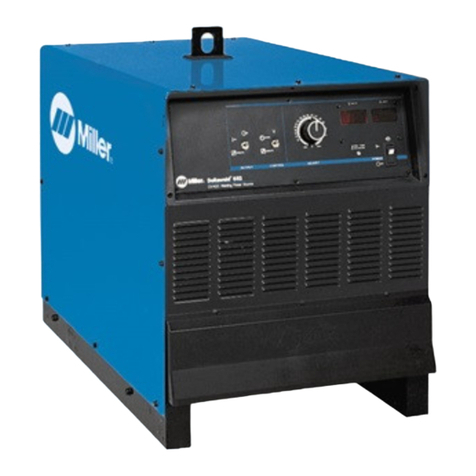
Miller
Miller Deltaweld Series owner's manual

Stel
Stel TIG mP 353H AC/DC instruction manual
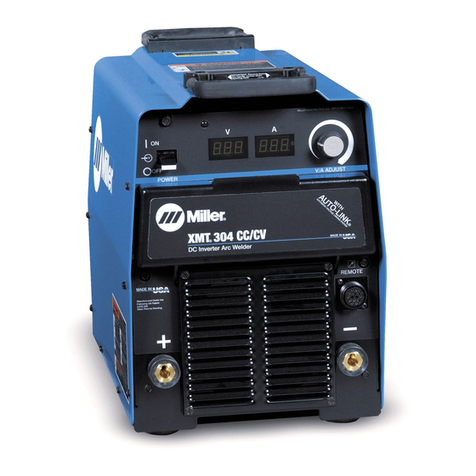
Miller
Miller XMT 304 CC/CV owner's manual

Lincoln Electric
Lincoln Electric VANTAGE 580 Operator's manual

Master Appliance
Master Appliance ProHeat PH-1400WK quick start guide
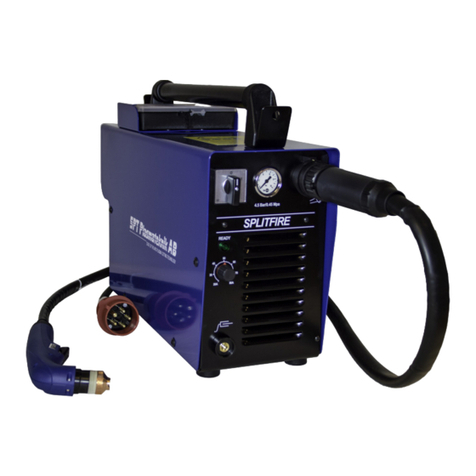
SPT Plasmateknik AB
SPT Plasmateknik AB SPLITFIRE Instructions for use
